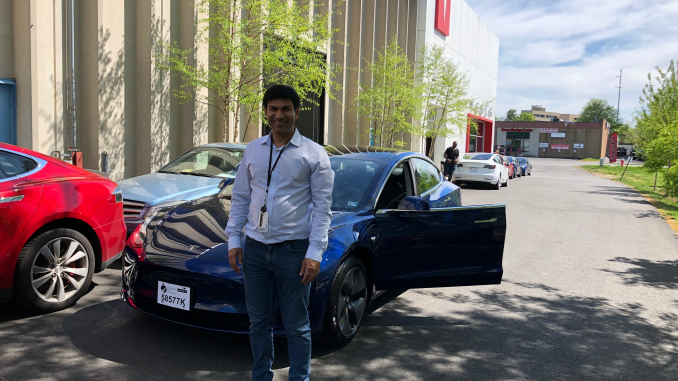
I recently bought a Tesla Model 3 AWD, extended range version. I’m not the type to talk about things you can buy with money that you didn’t create yourself, because I’m of the opinion that the joy of creating something with your own effort far exceeds acquiring things that someone else created. However, I’ve rarely felt more excited about owning a car than I did with the Tesla, so I felt I’ll write about it.
If you follow the news, you’ve heard something about Tesla. News about Tesla is usually about the latest histrionics of Tesla’s CEO Elon Musk, the volatility of the share price or the autonomous driving features, which is a bit unfortunate because it misses the bigger point – that Tesla cars are sleek, well designed and a sheer joy to drive. If you doubt that the future of mobility is electric, test driving a Tesla will put your doubts to rest. Plus, this future is already here and within reach of anyone able to afford a Mercedes E class or a BMW 5 series.
As I was working on this blog, I started looking into the history of Electric Vehicles (EV). What I discovered is quite fascinating. I’ll describe the major milestone below. I also highly recommend watching the movies “who killed the electric car” and its follow up – “revenge of the electric car” (must watch the second one, because the first one will likely leave you disheartened and *quite* angry at a certain car company based in Detroit). The U.S. Department of Energy also has a nice timeline of electric cars.
Brief history of electric cars
Many people think EVs are “in the future”, the next step in the evolution of automobiles. The opposite is true. The first automobiles were in fact electric and electric vehicles dominated in the first decade of the 20th century, accounting for 30% of all vehicles on the road.
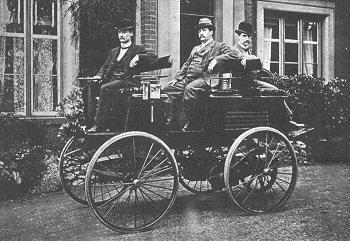
However from the 1920’s onward, the increasing popularity of gasoline powered Henry Ford’s Model-T, discovery of cheap crude oil in Texas and other places in the world and better roads led to a slow decline in EVs and by 1935, they had all but disappeared.
Over the next 70 years, EVs saw some sporadic, small scale revivals such as the Sebring-Vanguard’s Citicar in the 1970’s and GM’s EV1 introduced in 1996 but by and large, mass adoption was limited by performance and range issues.
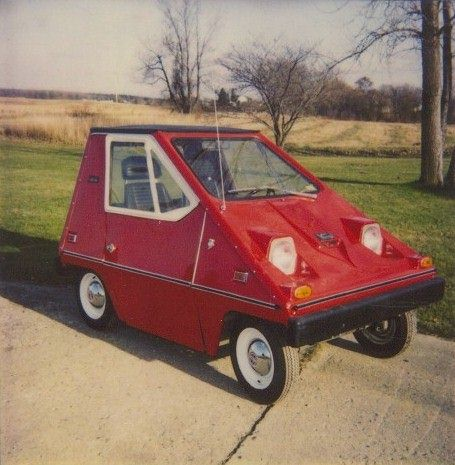
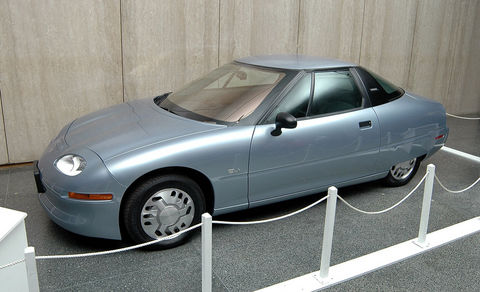
This all began to change with the introduction of hybrid cars. In 2000, Toyota introduced the first mass-produced hybrid, the Prius, which became an instant success with celebrities and continues to be a popular hybrid car model. Other big car makers quickly followed with their own hybrid models – the Insight from Honda, Ford Escape and many others.
The next step change came in 2006 when Tesla Motors, a Silicon Valley startup, announced it will produce a luxury electric sports car with a range of 200+ miles. Elon Musk, flush from the sale of PayPal, led the first few rounds of investment in Tesla and became CEO in 2007. According to this Wikipedia article, Musk claimed in 2017 that Tesla was started in response to GM’s cancellation of the EV1 program.
Under Elon’s inspirational but sometimes erratic leadership, Tesla quickly established itself as the leader in luxury electric cars with the Tesla Roadster followed by the less pricy model S. At a price tag of ~80K, the model S was well outside the price range of the average car buyer, but not so expensive that only the extremely wealthy could afford it. If you live in one of the top metro areas in the US, you were likely to have seen model S cars and perhaps been impressed by their sleek, futuristic design. Tesla’s strategy of appealing to the high end of the market first by designing powerful, fast, sleek cars with sufficiently long range turned them into an aspirational brand in the minds of consumers and dispelled many of the myths around EVs about their range, speed, and being only for the tree huggers. Even the former Fox news host Bill O’Reilly bought a Tesla and started rooting for the company!
My decision to buy a Tesla
Few months back, when my 9-year old Mercedes C class started showing signs of age, I wondered if I should just get a new car rather than sink ever increasing amounts of money on repair. I was generally happy with the Mercedes, so my first thought was to get another similar car – I called up the Infinity and BMW dealerships and did a few test drives. I found the latest models to be a slight improvement over my car in driving experience and moderately better in the media and entertainment features – touch screen consoles, better phone integration, rudimentary self-driving features, but nothing particularly inspiring.
This got me thinking that if I’m going to spend another 35-40K on a gasoline car that will at best be an incremental improvement over my current car, why not spend a bit more and get an electric car. Tesla was an obvious choice, but I also wanted to explore options from the standard car makers. To my surprise, I found hardly any. BMW has the i3 and the i8. The i3 has a weird boxy shape and gets around 150 miles per charge, half that of a Tesla model3
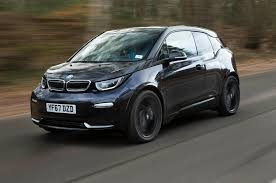
The i8 is a hybrid vehicle and in the ultra luxury range (~140K). BMW also has hybrid versions of its 3, 5 and 7 series cars and the first all-electric sedan, the i4 is scheduled to be launched in 2020.
Mercedes is surprisingly behind the curve when it comes to hybrid and electric vehicles. The only hybrid it offers is the GLC SUV.
Lexus offers several hybrid options (without bothering to proof-read their hybrid products page (retrieved 5/18/2019), see below), but doesn’t currently offer any electric options and none seem to be in the works
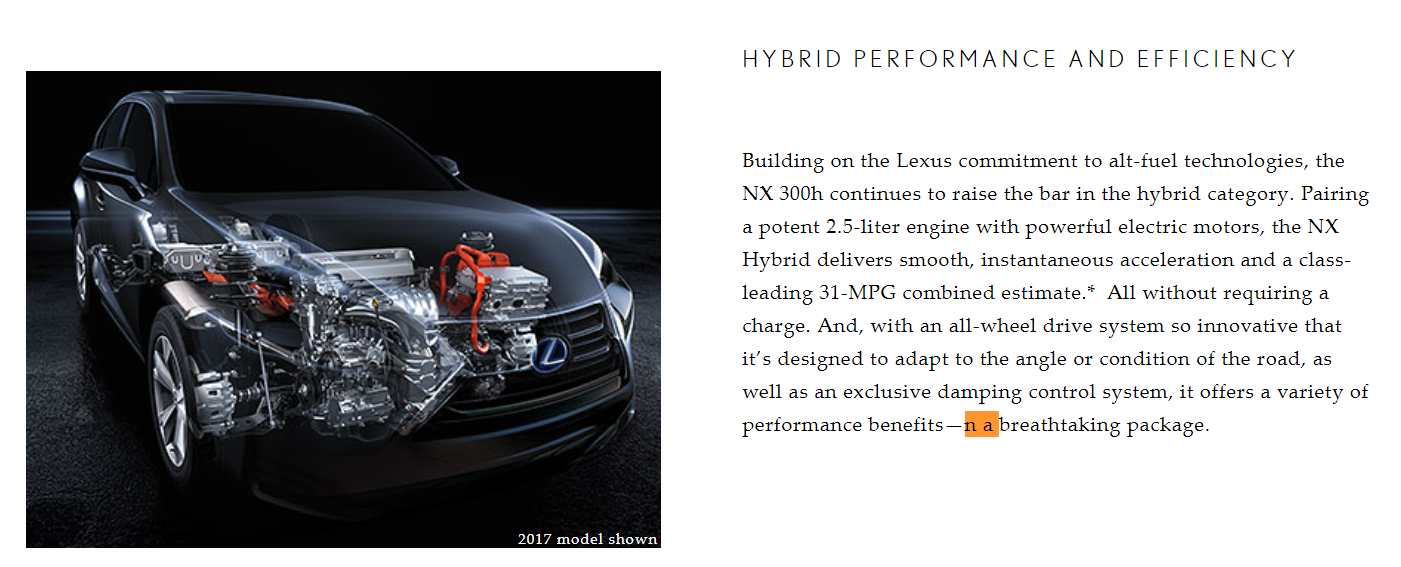
There is the Leaf from Nissan, however the design is uninspiring and the top end model (as of May 2019) gets 226 miles per charge, almost 100 miles fewer than the model 3 extended range. And finally, there is Chevy Volt from GM, the EV1 killer. I believe in holding companies accountable for their behaviour and therefore I’m a never GM’er (watch the “who killed the electric car” movie).
This left Tesla as the only viable maker for an electric car. Having decided on the maker, I now had to pick the model. The two options were the model S and the recently launched model 3. There is also the model X and Y, but I was looking for a compact sedan and those are bigger cars. I was a bit hesitant to buy the model 3 given that it was launched in 2018 and was probably going through teething problems common for new car models. A new model S starts around 75K and was a bit outside my price range. Thus, I started looking at used Model S cars. Tesla has a nice used car program (consisting mostly of model S cars) where one can buy manufacturer approved used cars with an updated warranty. I liked a couple of cars that were located within ~200 miles of my area but before placing an order, I wanted to do a test drive first.
So I went to the Tesla dealership (dealership is a slight misnomer, because unlike regular dealerships that operate on a franchise model and are owned and operated by third parties, Tesla dealerships are run by Tesla itself) in Tysons Corner and test drove both a model S and a model 3. During the test drive, once we were out on the highway, the Tesla rep asked me to step on the accelerator pedal. I have driven some high-end BMW’s and Audi’s before, so I thought I knew what quick acceleration felt like. However, the explosive acceleration of the electric car delivered by the smooth, instantaneous torque of the electric motor just blew my mind. Any lingering doubts about the wisdom of buying an electric car melted away instantly. We also tried the Tesla Autopilot with enhanced features such as automatic lane changing, self-parking and car summoning. Those were cool, but the acceleration and the sleek design of the car were by far the biggest selling points.
After the test drive, we discussed my concerns about teething problems with the model 3 and delivery time (I had heard there was a backlog of orders for the model 3 and customers had to wait for months to take delivery). The specialist at the dealership assured me that the initial problems had largely been addressed in the latest model 3’s and I can get delivery in less than 2 weeks.
I mulled the decision over on the drive back home and did some research. According to the buzz on Tesla forums, the initial problems with the model 3 appeared to have been largely resolved. The decision to get a new model 3 instead of a used model S came down to two factors – the availability of the all-wheel drive (AWD), extended range option on the model 3 which gets 310 miles per charge, which was significantly better than the ~240 miles/charge that I was seeing on used model S in my target price range and the full autopilot hardware (HW) that comes on new model 3’s but not on the older model S.
The Tesla autopilot comes in two versions – “Autopilot (AP) with convenience features” which basically includes lane following and cruise control and the “enhanced AP” which adds automatic lane changing, self parking and car summoning. AP with convenience features enables your car to steer, accelerate and brake automatically for other vehicles and pedestrians within its lane. The enhanced AP is intended to eventually enable full self-driving capability. It relies on extra cameras and additional sensors that were only added from 2016 onward. While the AP with convenience feature comes standard, the enhanced AP is available as an add-on (+$6000 at purchase time, more if added after purchase).
Since I work in AI, I generally understand how Tesla’s autonomous driving system works. It relies on object recognition and scene understanding driven by deep neural networks operating on the feeds of multiple cameras and distance sensors located all around the vehicle. I recommend watching Andrej Karpathy’s (head of AI at Tesla, and author of many popular AI blogs) presentation during Tesla’s autonomy day presentation video (https://www.youtube.com/watch?v=Ucp0TTmvqOE, Karpathy’s part starts around 1:50:00 in the video). He provides a nice overview of how Tesla’s AI driven autonomous driving system works and how Tesla uses the vehicles already on the road to continually improve the system. Notable, the Tesla sensor suit doesn’t include LiDAR, used by Waymo and other companies in the autonomous driving space. Elon Musk is famously bullish on full autonomy and promised in a recent investor call that a fully autonomous Tesla robo-taxi fleet will be operational sometime next year and Tesla customers can use their cars as robo-taxis when not using the cars themselves. I think that future is many years away at best.
The important point is that all recently manufactured Tesla’s feature all of the hardware (including the sensor suite and Tesla’s new Deep Learning inference processor – to learn more about that, watch Pete Bannon’s presentation, which is before Karpathy’s in the video linked above) necessary for full autonomy, and improvements to the autonomous driving software can be installed as a software update. This got me thinking about the wisdom of buying a used model S, which wouldn’t have the full autonomous driving hardware. I didn’t care about the enhanced AP software as it is today but wanted to reserve the option of installing it later, when it becomes actually useful. Buying a new model 3 with all of the cameras and sensors necessary for full autonomy allowed me to have that option. Plus, the additional cameras and sensors improve the performance of the AP with convenience features and provide proximity information helpful while parking in tight spaces
Building a model 3
Like most premium automakers, Tesla lets you “build” your vehicle by selecting various options on their website. Currently (May 2019), the model 3 starts with the “Standard Range Plus” option at $39,900. There are two upgrades, the “Long Range” option at $49,900 that increases the range from 240 miles to 310 miles and the “Performance” option at $59,900 that features better 0-60 acceleration and a higher top speed (so at 162 mph, you can zip past cars going at only 140 mph on America’s crumbling roads). For each of these options, you can pick the color, wheels and the interior style. If you select anything other than the default option, you’ll pay more. For example, red color (+$2000) with 19 inch sport wheels (+$1500) and black and white interior (+$1000) will cost you an additional $4500. Finally, picking the enhanced AP will cost you another $6000. As Tesla’s self-driving technology improves and new features are added, the enhanced AP software will automatically be updated via over-the-air software updates, much like a smart phone. You can choose to install enhanced AP later (instead of at purchase time), however it will cost more.
So, a fully featured performance model 3 with enhanced AP currently costs $70400, which is almost the starting price for a model S.
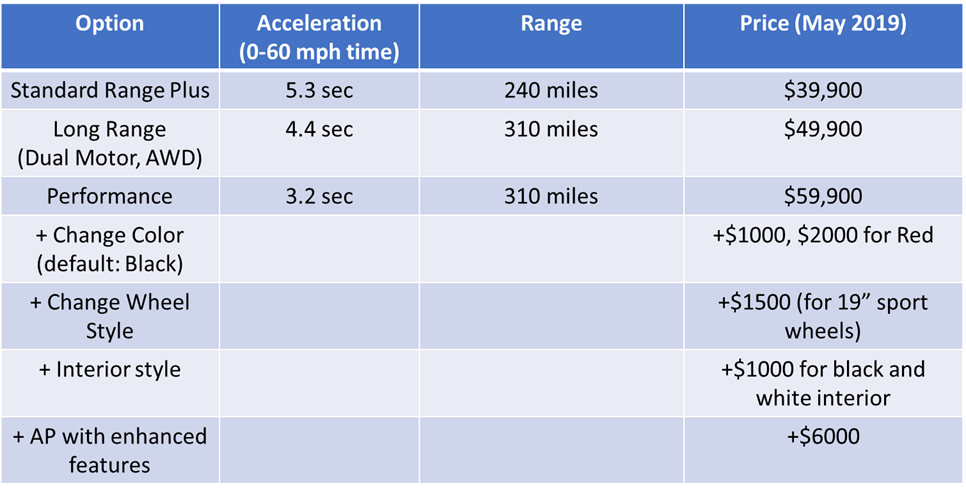
I picked the extended range version in blue color and chose not to get the enhanced AP. I’m a little bit skeptical of the timeline of when the enhanced AP features will be reliable enough to be actually useful. Achieving full autonomy is a very hard problem. Many companies are 90% of the way there, but to solve all the weird edge cases that happen in real life will take time, in my opinion.
Placing your order
Once you select your car, you’ll need to deposit $2500 to place your order. The delivery time varies by location, in my case it took about a week to get the car.
To make the buying experience easier, Tesla provides financing and the option to trade-in your current car. The financing options are very competitive (at least for people with good credit) and I was able to get a loan at an interest rate only about 1% higher than the corresponding U.S. treasury yields. I find comparing loan APRs against corresponding treasury yields a good way to determine how competitive your APR is. It is possible to obtain external financing (not through Tesla), however that will make your paperwork more complicated. Just to be sure, I shopped around for other loan offers (Capital One, Chase and couple other banks) and found the Tesla loan offer to be the most competitive.
Tesla also offers to trade-in your current car and will match third party trade-in offers (obtained in writing). I took my car to Carmax whose offer was a few hundred dollars more than Tesla’s, which Tesla then matched. They make the whole process quite easy – you just upload an image of the third party offer on your Tesla account and the trade-in offer will be updated automatically.
Taking Delivery
My car arrived at the Tesla dealership a week after I ordered it. You can either pick the car up yourself or the dealership will drive it to where you live. Since I couldn’t wait to take delivery, I scheduled a delivery appointment as early as possible and drove to the dealership myself. They had all the paperwork ready to go and had already registered the car with Virginia DMV. I received temporary tags valid for one month and received the license plates with 1 year tags couple of weeks later in the mail. No trip to the DMV required! I had already added the new car to my car insurance policy before I left for the dealership. The entire experience was quite efficient and pleasant, as I had expected.
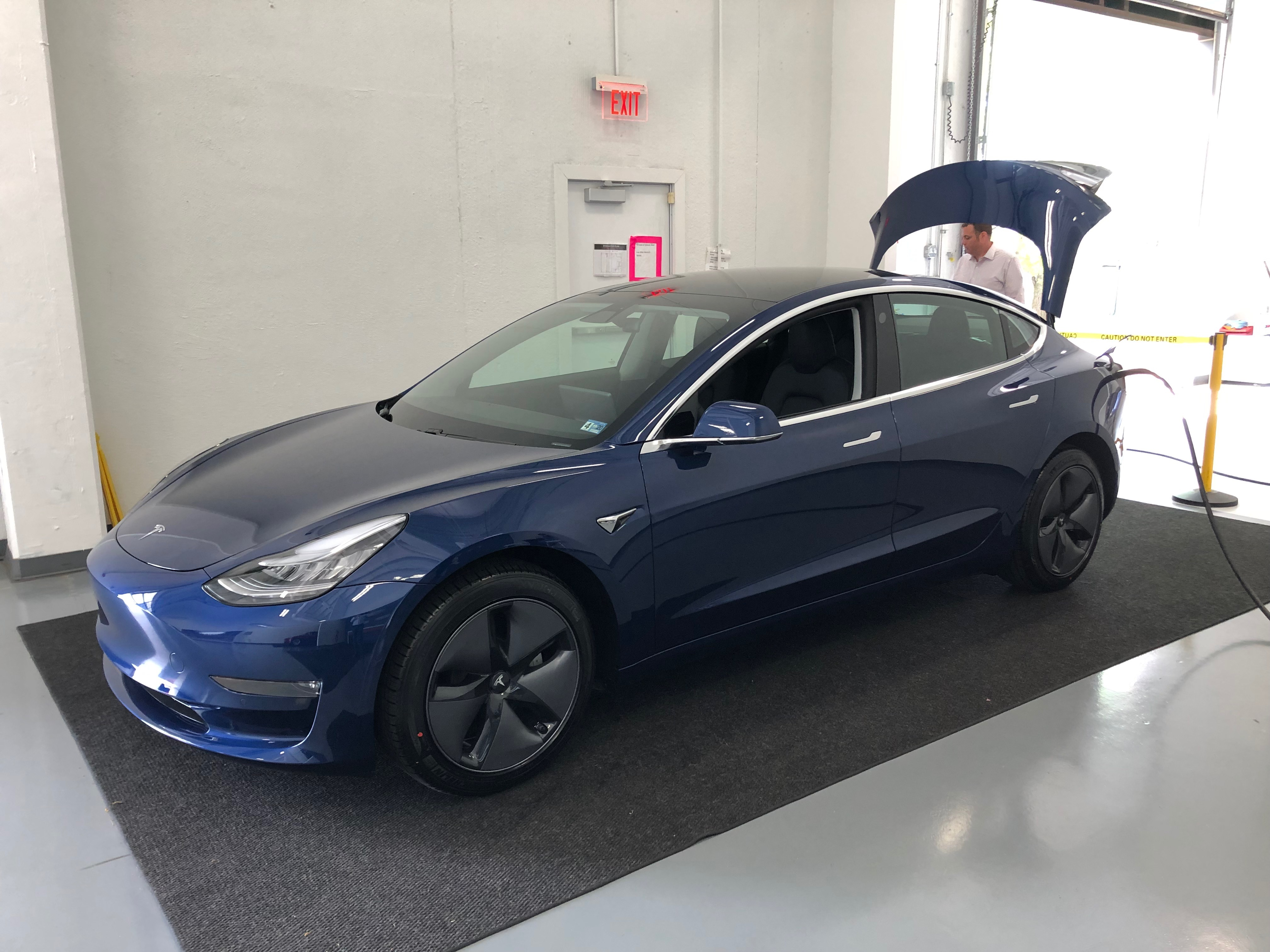
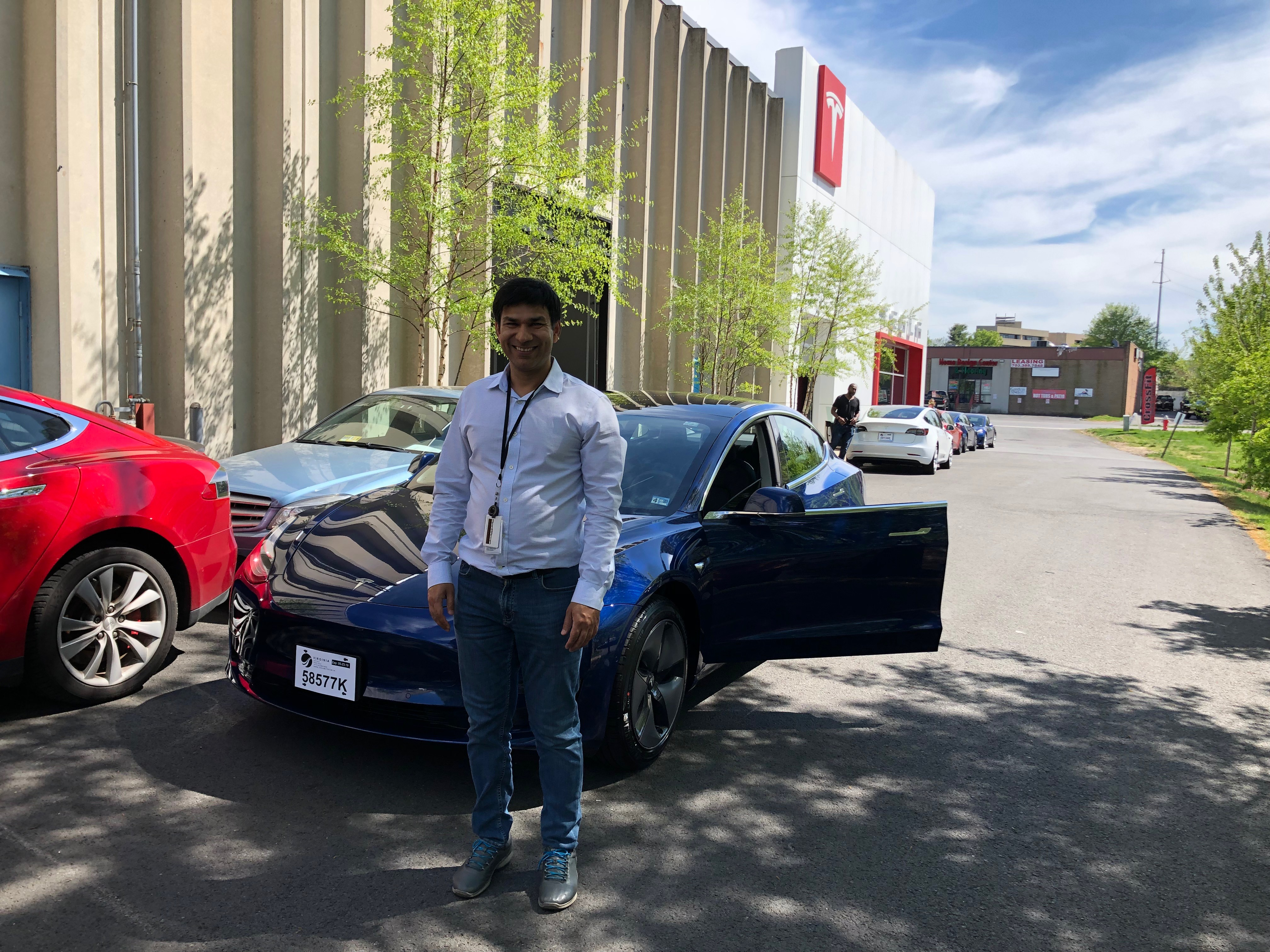
I had expected a longish “new car orientation” session at the dealership to become familiar with all the settings, charging best practices and so on. However, after my paperwork was complete, the delivery assistant took the keys to my old car, showed me how to pair my phone to the car (which acts as the key) and that was it! I asked a few questions about how to charge the car, whether I should charge to 100% of the battery capacity or slightly below etc., which the delivery assistant answered competently. Most of the features on the Tesla are quite intuitive and easy to figure out in due course, but I do think that a 15 min orientation (particularly around the autonomous driving features) would be helpful to new customers who may not be very tech savvy.
Experience so far..
I have owned the car for about a month now and I couldn’t be happier. The car makes gasoline cars feel positively out of the 19th century. Starting off from a stop light, it is fun to leave behind in the dust the biggest, baddest models of German engineering. The controls are all very intuitive and smartly designed. Other cars have the speedometer and other gauges behind the steering wheel, straight in front and slightly below the line of sight. On the Tesla, all the controls are on the touch screen control pad located to the right of the steering wheel. I was a bit apprehensive if glancing sideways to look at the control pad would be distracting, it isn’t.
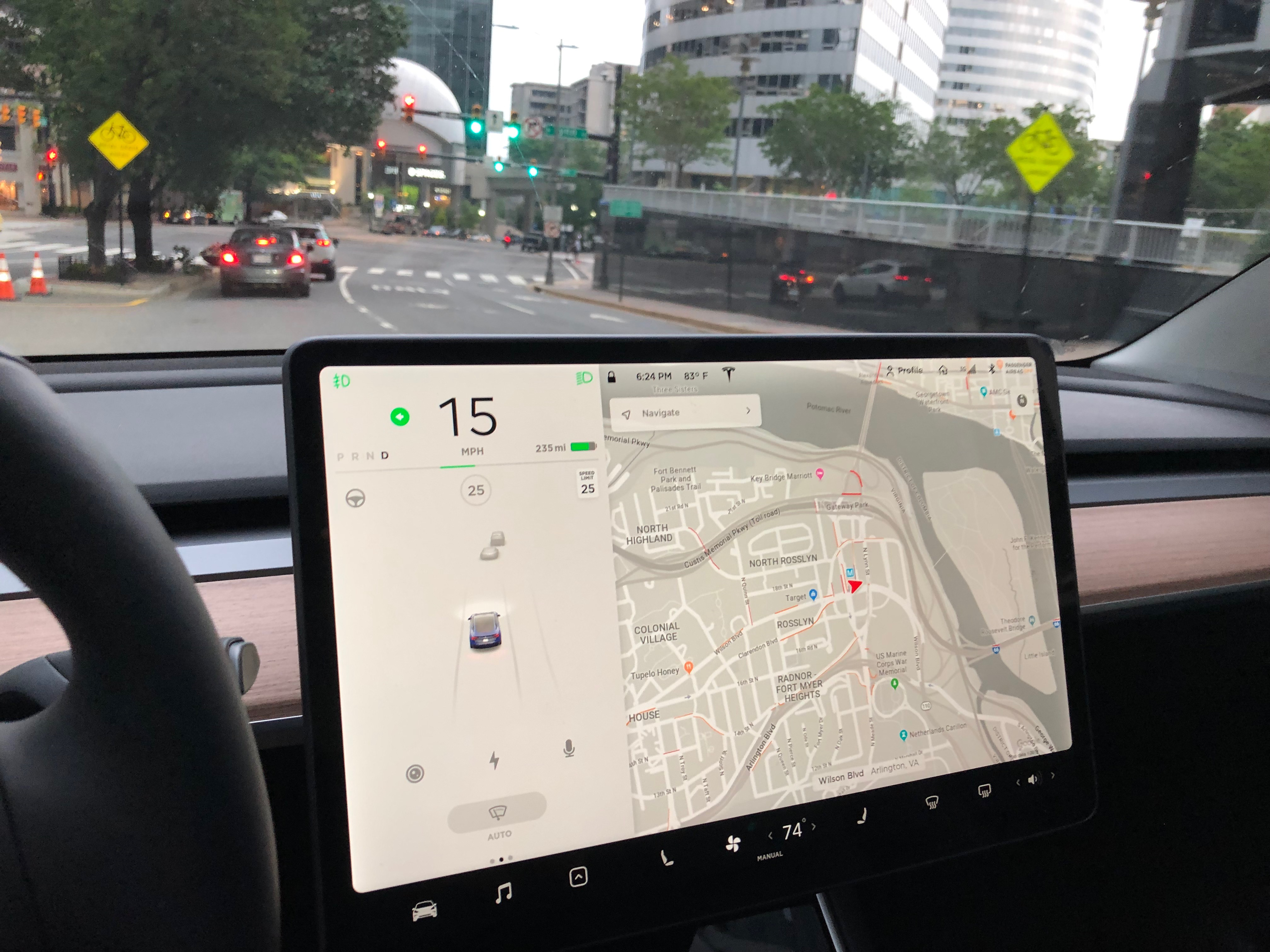
The touch screen UI and controls are intuitive, responsive and easy to use. You can tell they have been designed by a silicon valley company, not by a traditional car company. The sound system is fantastic. The cameras and distance sensors located all around the car make parking in tight spots without hitting the curb or the car in front/back a breeze. The navigation system with verbal, turn-by-turn directions is well designed and easy to use. My old Mercedes also had a navigation system, but it was so clunky that I invariably relied on my phone for directions. On the Tesla, I always use the car’s navigation system.
You can use your phone as the “key”, so the car automatically unlocks when you are carrying your phone and approach the car. It is nice not having to carry a bunch of keys around.
The car has its own internet connection and can play streaming music. I’ll need to figure out how the connection is paid for. I’ll report back when I do.
The parking garage in my office building has free electric car charging (~24 miles/hour), and that has been working out splendidly so far. I haven’t taken the car out for a long trip, so haven’t had to use Tesla’s superchargers yet.
I was out for a work trip last week and was wondering how much charge the battery loses per day when the car is parked. I recorded the number of miles when I left for the trip and after I came back – and the answer is roughly 1.5 miles a day. So nothing to be concerned about, unless you plan to leave the car parked for more than half a year. I rented a gasoline car for my work trip and it felt like a huge downgrade.. particularly the media controls.
Regenerative Braking: Applying brakes on a regular car converts the kinetic energy of the car into useless heat energy. Hybrid cars such as the Toyota Prius and EVs have “regenerative braking”, which captures part of the car’s kinetic energy and converts it back into electricity used to recharge the battery. This occurs by using the car’s electric motors as a generator, producing electricity instead of consuming it. You can feel the effect of regenerative braking when you let your foot off the accelerator (I was going to say “gas”..) – a regular car will coast, the Tesla will start slowing down as if you are also applying brakes. The control panel has a color-coded indicator (see horizontal bar below the speed in the picture above) that tells you when you are using the battery (indicator shows gray), vs. when you are charging the battery via regenerative braking (indicator turns green). Because of regenerative braking, you can almost drive the car without using brakes, specially in urban environments. When you want to slow down, you simply let your foot off the accelerator. You only need to use brakes to come to a full stop. Besides increasing the number of miles per charge, regenerative braking also reduces wear on your brake pads, so you’ll need to replace the pads far less frequently.
Since I haven’t taken the car out on a long drive yet, I have only used the autopilot features sporadically (they don’t work well in city driving). As mentioned before, I didn’t get enhanced autopilot, so the autopilot features available on my car are lane following and automatic speed control. Both features work well during highway driving. You can still use the accelerator pedal in autopilot mode and the car will continue to follow the lane. Since these are driver assist features and not full autonomy, you are required to apply gentle pressure on the steering wheel every 15-20 seconds. If you fail to do so, the car will disable autopilot for the duration of that trip! I think this is quite smart..
Yesterday, the car installed the first SW update since I purchased it. The software update was downloaded automatically and the car (both via the control panel and the smart phone app) will tell you what’s in the update, how long will it take to install it and let you schedule the installation. Felt very much like installing an iOS update!
Conclusion
As I mentioned earlier, if you have doubts about the future of mobility, you should test drive a Tesla. Chances are that your doubts will be laid to rest. The company has designed an excellent car, which is a joy to drive. Tesla is unfortunately in the news more often about Elon Musk’s histrionics, stock price volatility and promises not kept about autonomous driving features, rather than their cars. What gets lost in all this noise is that Tesla’s are great cars – sleek, elegant and well-designed aside from all the self-driving features. For many city/suburban dwellers with access to charging at work or at home, EVs are already a practical, safe and affordable option.
Finally, a few words about the environmental aspect of driving an EV. Being a zero emissions vehicle, EVs obviously don’t belch polluting gasses into the atmosphere. However, the picture becomes more complex when the entire production cycle of an EV is considered. Manufacturing Lithium Ion batteries is a highly energy intensive process and uses metals such as cobalt which are expensive to make. Some EVs, including Tesla Model 3 long range (see this article) use permanent magnet motors which use the rare earth metal neodymium in the magnets. These metals are mined only in a handful of countries, biggest of which is China. Given the ongoing trade conflict between the US and China, the availability of these metals probably presents a business risk for Tesla. The price of neodymium is now about $70 a kg, but hit $500 after China held back shipments to Japan in 2010 during a row over disputed islands. I think ultimately, recycling as many of the battery components as possible is the long-term solution. Tesla already has partnerships with many recycling companies to make the battery lifecycle a closed loop system.
That’s it! Hope you found the post entertaining and useful and that you consider an EV when selecting your next car 🙂

How is the wireless connection paid for?
Free for the first year and then $10 per month